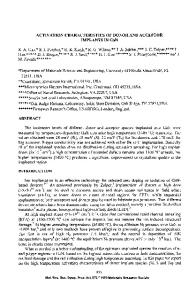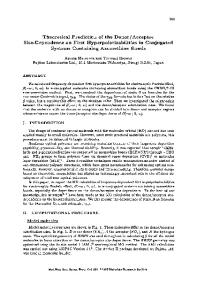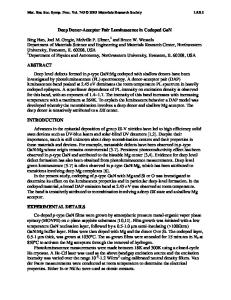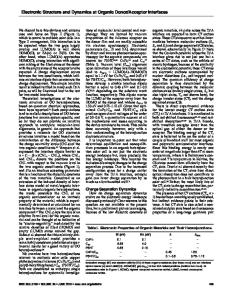The Investigation of Donor and Acceptor States in the Nanoparticles of PbI 2 Layered Semiconductor
- PDF / 420,092 Bytes
- 6 Pages / 414.72 x 648 pts Page_size
- 68 Downloads / 253 Views
STATES
IN
THE
E. LIFSHITZ * * Permanent address: Department of Chemistry and Solid State Institute, Technion, Haifa 32000,
Israel, [email protected] ABSTRACT The nanoparticles of PbI2 layered semiconductor, embedded in Si0 2 films, were prepared by the sol-gel method. The low-temperature luminescence of PbI 2 nanoparticles consists of a series of exciton lines in the region of -2.5eV and additional donor-acceptor recombination luminescent bands at lower energies, centered at 2.44eV (Green) and 2.07 eV (red), respectively. This paper reports the investigation of the nonexcitonic transitions, associated with of the Green and Red bands. The correlation between donor-acceptor recombination emission processes and lattice imperfections was examine, utilizing optically detected magnetic resonance (ODMR) spectroscopy. The results identified the following imperfection sites of both the Green and Red bands: an acceptor site associates with an isotropic Lead vacancy defect, [V-]Pb 2' and a donor site, associate with an anisotropic Iodine vacancy, [V']1 odin. However, the results pointed on differences in relaxation processes of these bands. The relaxation processes correspond to the existence of competitive nonradiative recombination, spin-lattice relaxation and thermalization among the spin substrates. Thus, the results suggest that the Red band corresponds to stoichiometric defects at the surface, while the Green band corresponds to the same stoichiometric defects at the interior part of the nanoparticles. INTRODUCTION Lead iodide, PbI 2, is a direct band gap semiconductor with a layered structure. Compounds exhibiting a structure of this kind possess strong intralayer bonding and only weak, so called, van der Waals interlayer interactions. The band-edge optical properties of PbI 2 single crystals have been studied extensively for about two decades [1]. However, there are only few studies of these properties in the corresponding nanometer-sized particles (nanoparticles) 12,3]. The low-temperature photoluminescence (PL) spectrum of PbI 2 nanoparticles consists of a series of exciton lines in the region of -2.5 eV and additional broad luminescent bands at lower energies centered at 2.44 eV (Green) and 2.07 eV (Red), respectively. Although it has been shown that the absorption and photoluminescence spectra of nanoparticles exhibit similar properties to those of the bulk [2,3], several differences arise for the following reasons: (1) When the particle radius approaches the size of the exciton Bohr radius (with bulk crystallographic structure), size quantization takes place [4]. The latter is pronounced as a blue shift in the optical transitions, (2) Due to the large ratio difference between surface/bulk atoms in the epitaxial and nanoparticle samples, there may be a proportionally larger amount of surface defects. These are capable of acting as traps for photogenerated excitons, holes or electrons and may alter the recombination processes. Recently we have reported the study of the exciton properties in the nanopart
Data Loading...








